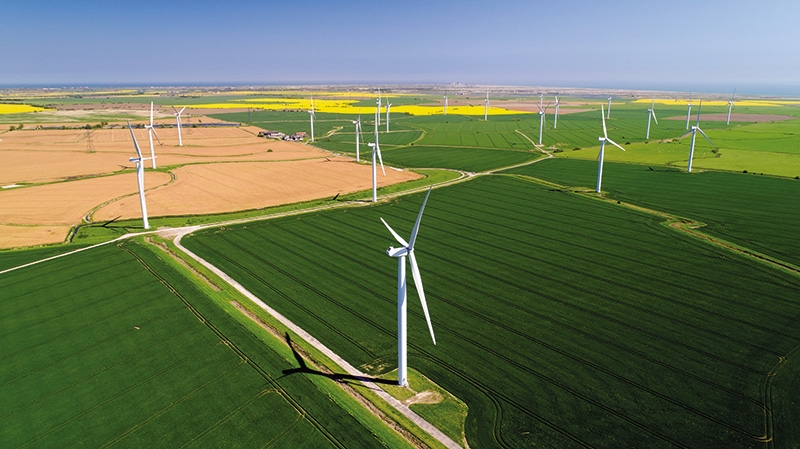Taking advantage of the energy potential
 |
| Vietnam is an ideal candidate for wind energy development, Photo: Shutterstock |
Vietnam has an encouraging opportunity to move away from its reliance on foreign coal and develop its own modern renewable energy system free from pollution of its air, waterways, and agricultural land. Over the past few years, steps have been taken to implement a system primarily run on renewables. While more attractive incentives and regulations are still needed, the rich potential for clean energy is enough to remain hopeful of a gradual transition to a system fuelled by abundant renewable energy sources.
 |
| Katie O’Connell, associate of ACSV Legal Vietnam |
Sparked by political and economic reforms under doi moi in 1986, Vietnam has experienced a steady shift from one of the world’s most impoverished nations to a low- and middle-class country. Since then, Vietnam has maintained its position as one of the fastest-growing economies in the world. At the same time, the demand for energy to support the expanding infrastructure has increased almost twice as fast as GDP.
In 2016, 99 per cent of the population used electricity as their main source of lighting, up from 14 per cent in 1993. More specifically, between 2011 and 2016 the demand for electricity consumption grew approximately 11 per cent annually. Given the forecast of continued development in Vietnam, the energy demand will likely continue to increase over the next 15 years.
To address the rapidly rising demand for electricity, the Vietnamese government has introduced several modest policies and plans to attract investment to the energy sector. While these policies have addressed the growing industry, a stronger legal and regulatory framework along with more competitive incentives is still required.
At the moment, Vietnam is powering the majority of its growth on fossil fuels (coal and gas). What’s more, Vietnam’s Power Development Plan VII (PDP) outlines an increased reliance on these fossil fuels. In 2015, Vietnam had total installed capacity of 33.45 per cent in coal energy sources. According to the PDP, by 2030 coal is projected to provide over half of the total electricity, making it the primary source for electricity production within the country.
With limited domestic coal and gas resources, Vietnam’s fossil import dependency will necessarily increase. In 2017, the demand for imported coal sat at 11.7 million tons. By 2030, the PDP estimates that demand will increase to 102.1 million tonnes.
Although renewable energy trends show positive mobility, the energy source is forecast to account for only 11 per cent of the total installed power by 2030. According to the Vietnam Energy Association, if the country does not increase the share of renewable energy in the sector, the proportion of energy that the country will need to import by 2030 will rise from 3 per cent of primary energy demand to as much as 44 per cent, instead of the targeted 24 per cent. This substantial reliance on importation exposes the energy security of the nation. As such, there is a significant need to tap into this potential for renewable energy that is presently being largely neglected.
Benefits and sustainability
It is widely accepted that renewable energy is a healthy energy source for the environment, through minimised air pollution and reduced greenhouse gas emissions. Additionally, wind energy provides several benefits that support the transition to clean fuel sources, such as enhanced energy security, creation of domestic jobs, and significant cost benefits.
One of the most attractive benefits of wind energy is the enhanced energy security it provides. Because of the indigenous nature of the source, the local economy is insulated from the volatility associated with imported fuel prices and other unpredictable factors associated with importation of energy sources. Wind energy is also sustainable. It is generated by the sun’s heating of the atmosphere, the rotation of the earth, and the earth’s surface irregularities. Therefore, so long as the sun shines and the wind blows, the energy produced can be channelled to send power across the grid.
Meanwhile, a huge benefit is the development of local industries and the creation of domestic jobs. Based on the industry’s long supply chain, the sector has the potential to create a significant number of local jobs. Currently, the global wind industry currently employs about 1.15 million people worldwide.
In 2017 alone, $107 billion was invested globally into the industry. In Vietnam, foreign investors have turned their attention towards the nation’s wind energy sector over the past several years. International investment into Vietnam is undoubtedly a major advantage for the continued growth of the economy.
Furthermore, wind energy is one of the lowest-priced renewable energy technologies available today. At 4-6 US cents per kilowatt hour (kWh), depending on the wind resource and project financing, the low cost serves as a major benefit.
Over the past several years, wind energy has become an important renewable energy source both domestically and worldwide. In 2016, over 54 gigawatts of wind power was installed globally. According to a recent report by the Global Trade Association, the cumulative global capacity of wind power grew by more than 12 per cent in 2017, to reach a capacity of 486.8GW worldwide.
Within its borders, Vietnam’s abundant potential for wind energy is just beginning to be exploited. Over 3,200 kilometres of coastline, coupled with the monsoonal climate, make the country an ideal candidate for wind energy development. In the Department of Commerce’s Renewable Energy Top Markets for United States Exports published in 2016, Vietnam wind power generation market ranked at number 28, and the country is considered to have an unrivalled supply of wind resources in Southeast Asia.
The German International Agency estimates Vietnam’s wind energy potential at 10GW, while the World Bank Wind Atlas offers a more optimistic estimate of 24GW. Nevertheless, the Vietnamese government has acknowledged this large potential in the PDP by targeting wind energy production to reach 800 megawatts by 2020 and 6,000MW by 2030. While these numbers are attainable, legal and regulatory barriers need to be broken in order to facilitate such vast development.
The first wind farm in Vietnam, the 24 MW Phu Lac plant, began operations in 2016 in the central province of Binh Thuan. As of June last year, seven wind farms have been installed in Vietnam with a total capacity of 189.2MW. Over 40 additional wind power projects with a total capacity of 5,000MW have been registered, although only three projects have been added to the national grid.
In an attempt to grow this number, local authorities, under the approval of the government, have offered various incentives for investors. These incentives include the waiver of land lease fees for the project’s lifetime, corporate income tax (CIT) exemption for the first four years, 10 per cent CIT for the next nine years, and waiver of import tax for fixed assets in renewable projects. Additionally, such regional authorities have called on the Ministry of Industry and Trade (MoIT) to review and shorten the evaluation time for a project’s basic design, along with a request to raise the feed-in tariff (FiT).
Recent progress
Also last June, the Global Wind Energy Council held the first-ever Vietnam Wind Power conference in Hanoi, between German and Danish embassies and the Vietnamese government, to promote progress in the field. During the seminar, the Global Wind Energy Council recommended the abolishment of major regulatory barriers in the sector to ease the investment process. Additionally, the overseas embassies suggested the creation of a National Wind Power Association. The most important recent change made in the industry is the increased FiTs. According to Decision No.39/2018/QD-TTg issued on September 10, 2018, the FiT for wind energy projects has increased from 7.8 US cents/kWh to 8.5 US cents/kWh for onshore wind power projects, and to 9.8 US cents/kWh for offshore wind ventures. This increase, effective from last November, is expected to have a positive impact on the wind energy industry by providing a more commercially viable FiT for investors and developers in the Vietnamese market. Existing projects will also be eligible for the new tariff for the duration of their power purchase agreement (PPA).
In order to create long-term, sustainable development in the field, there are several key changes that should be implemented by the Vietnamese government. Under the current law, the government strictly regulates the retail price of electricity, pursuant to recommendation by the MoIT and approval by the prime minister. However, Vietnam Electricity (EVN) has absolute discretion to increase or drop the price within a margin of up to 5 per cent twice a year without seeking approval from the MoIT or the prime minister when input parameters, such as fuel prices or foreign exchange rates, change significantly.
This creates a great deal of uncertainty for investors in the sector. To encourage foreign funding in the field, more transparency in electricity rate forecasting is required. Additionally, the legal framework is unstable, and the regulatory environment is largely underdeveloped. Administrative burdens for investors, through national or provincial master plan requirements, inhibit investment and development significantly. Additionally, some projects may also require the approval of the prime minister or the MoIT before moving forward.
As it stands, the current PPA model is comparatively short when compared to PPAs used in other conventional power projects, and fails to sufficiently address a number of key issues that are important to international investors. Under Vietnam’s PPA, EVN is the sole off-taker and, although required to purchase all electricity generated by the project, it is not required to pay the tariff in the event of overhaul or maintenance of the electricity grid. There are few limitations to these interruptions and there are no “take or pay” obligations. This is a huge deterrent for foreign investors, based on the lack of power distribution and control over the sector.
Experts in the field have suggested the need for a Standardised Commercial PPA, whereby industrial energy buyers can purchase directly from energy producers, rather than using EVN as a middle-man. While the latest regulations have outlined the new model PPA, nothing at this time has been rolled out.
What the stars mean:
★ Poor ★ ★ Promising ★★★ Good ★★★★ Very good ★★★★★ Exceptional
Related Contents
Latest News
More News
- Heavy industries set for pilot greenhouse gas quotas (December 25, 2025 | 10:00)
- Swedfund invests in MSME growth and climate action in Vietnam (December 19, 2025 | 11:42)
- GreenYellow brings solar energy to light up remote schools in Tuyen Quang province (December 19, 2025 | 08:00)
- Charge+, Grab partner to develop EV charging network in Vietnam (December 18, 2025 | 17:11)
- Linking sci-tech and innovation to Vietnam’s net-zero future (December 18, 2025 | 14:31)
- Driving double-digit growth through green and circular transformation in Vietnam (December 17, 2025 | 09:00)
- Standard Chartered and ACCA deepen collaboration to develop Vietnam’s talent for a sustainable future (December 15, 2025 | 18:18)
- Schaeffler reports strong early output from Dong Nai solar project (December 12, 2025 | 15:16)
- Forestry conference highlights biodiversity and sustainability goals (December 09, 2025 | 13:35)
- Home Credit honoured among top 10 sustainable companies in trade and services (December 09, 2025 | 12:18)

 Tag:
Tag:



















 Mobile Version
Mobile Version